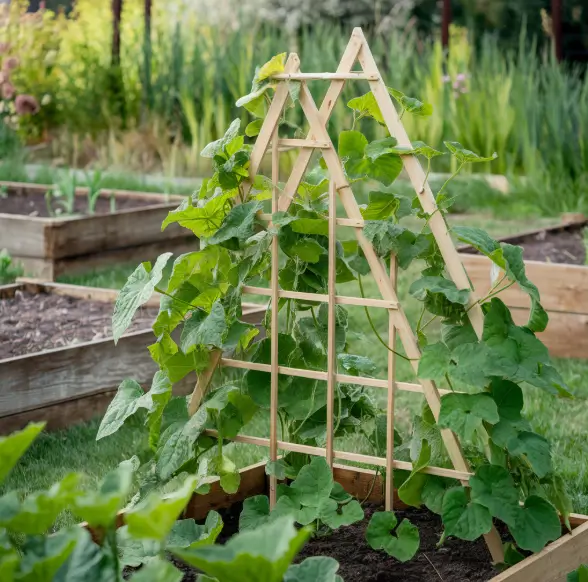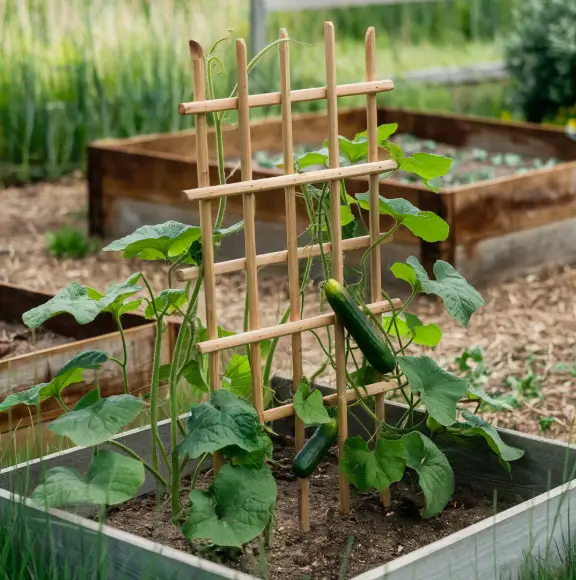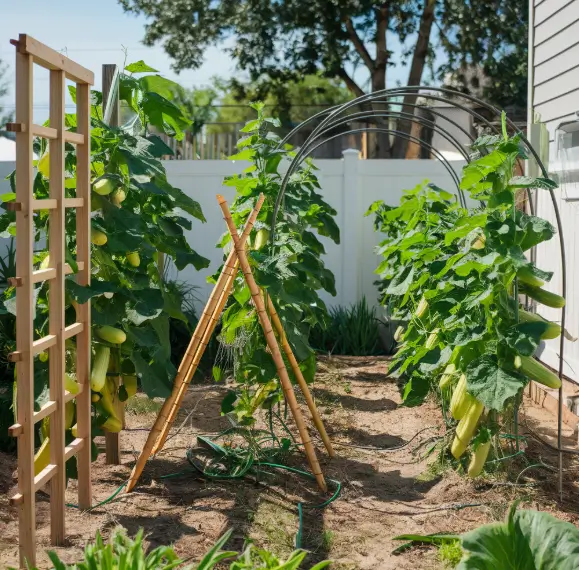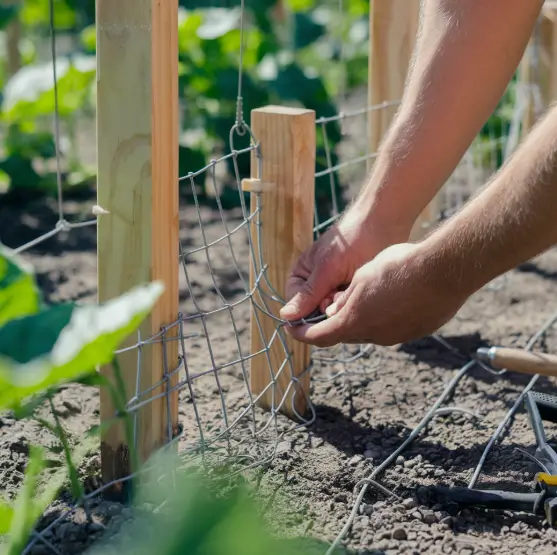When I first started gardening, it was with my abuela, my grandmother from Mexico. She had the most enchanting little backyard, where cucumbers climbed gracefully up a trellis she had cobbled together from old broom handles and bits of twine. I remember watching, fascinated, as she wove the vines gently through the homemade structure, whispering to the plants as though encouraging them. It was there, under the dappled shade of her towering tomato and cucumber vines, that I realized the powerful connection between structure and growth. Today, I carry on her tradition, crafting my DIY cucumber trellis every season — not just to maximize my garden’s harvest but also to honor the wisdom she passed down to me.
Let us embark on this journey together to build a thriving cucumber garden with sturdy, beautiful trellises.
Table of Contents
Why Cucumbers Need a Trellis
The Benefits of Using a Cucumber Trellis
Growing cucumbers on a trellis is not merely a matter of aesthetics. It serves several crucial horticultural functions that directly impact plant health and yield. By lifting vines off the ground, a DIY cucumber trellis minimizes pest infestations, fungal infections, and fruit rot — issues commonly associated with soil contact.
Elevating cucumber vines facilitates better air circulation, which significantly reduces the risk of powdery mildew, a common enemy of cucurbits. Furthermore, harvesting becomes considerably easier when fruits hang freely, are visible, and accessible. I recall bending awkwardly among dense vines before I built my first trellis; lifting them transformed gardening from a backbreaking chore into a delightful ritual.
How Trellising Improves Cucumber Growth and Harvest
In my experience, trellised cucumbers grow straighter, larger, and more uniformly. When vines sprawl across the ground, fruits can become twisted or malformed due to uneven sun exposure and crowding. Additionally, cucumbers growing vertically receive more consistent sunlight, leading to faster ripening.
Scientific studies also corroborate this. According to the University of Minnesota Extension, vertical gardening can increase yields by as much as 30%. Given these advantages, it is not surprising that incorporating a homemade cucumber trellis has become an indispensable part of my seasonal garden planning.

Types of DIY Cucumber Trellises to Consider
Vertical DIY Cucumber Trellis Ideas for Small Gardens
For those with limited space, such as urban or patio gardeners, a vertical DIY garden trellis for cucumber systems is ideal. I once helped a neighbor in our apartment complex build a simple, freestanding ladder trellis using reclaimed wooden pallets. Not only did it save space, but it also transformed her tiny balcony into a lush, edible oasis.
Some effective vertical trellis ideas include:
- String trellises are attached to a high beam.
- Bamboo teepees bound with garden twine.
- PVC cucumber trellis frames that are lightweight and weather-resistant.
Each method elevates the vines vertically, optimizing space while beautifying the area.
Angled and A-Frame Trellis Designs for Better Support
When growing heavier cucumber varieties, I often opt for an angled or A-frame trellis. These structures distribute weight more evenly and reduce the strain on vines. Building an A-frame can be as simple as hinging two wooden panels together and securing them into the soil.
Benefits of A-frame designs include:
- Increased stability against wind.
- Easier access for harvesting.
- Versatility for other climbing vegetables like peas and beans.
Last summer, my angled upright cucumber trellis withstood several storms, proving its reliability.
Creative Alternatives: Arches, Fences, and Ladders
Creative gardeners can transform common household items into elegant cucumber supports. Old iron bed frames, decorative garden arches, and chicken wire fences all make excellent trellises.
Incorporating a wire mesh cucumber trellis into your garden fence is both practical and visually appealing. Plus, it allows cucumbers to intermingle with flowering vines for a picturesque effect.
Materials and Tools Needed for a DIY Cucumber Trellis
Affordable Materials for Building a Cucumber Trellis
Building a cheap DIY cucumber trellis does not require costly materials. I often repurpose items found in sheds or thrift shops. Some economical materials include:
- PVC pipes or conduit.
- Wooden stakes or bamboo poles.
- Garden twine or nylon netting.
- Wire mesh panels.
Sustainability is important to me, and choosing upcycled materials not only reduces costs but also environmental impact.
Essential Tools for a Sturdy DIY Cucumber Trellis
While the materials may vary, certain tools are indispensable when constructing a reliable trellis. Every season, I prepare:
- A sturdy hammer and nails.
- A cordless drill with screws.
- A handsaw for custom sizing.
- Zip ties or garden clips for additional support.
With these basics, even complex structures like a wooden cucumber trellis DIY project become manageable. Precision in construction ensures that the trellis endures throughout the growing season and beyond.

Step-by-Step Guide: How to Make a Simple Cucumber Trellis
Choosing the Right Location and Preparing the Site
The success of a simple trellis for cucumbers begins with strategic site selection. Cucumbers grow best in areas with plenty of sunlight and soil that drains well. I always pick a location that receives at least six hours of direct sunlight daily.
Steps to prepare the site:
- Clear weeds and debris.
- Loosen the soil with a garden fork.
- Amend the soil with compost for nutrient richness.
- Install irrigation lines if necessary.
Proximity to water sources simplifies maintenance, and a clear, unobstructed area ensures that cucumbers can climb without hindrance.
( learn more about how to care for the soil here.)
Building a Basic Wooden or Wire DIY Cucumber Trellis
Constructing a building a trellis for a cucumber project can be both simple and satisfying. One of my most successful designs involved:
- Assembling two wooden frames (3 feet wide by 6 feet tall).
- Covering them with galvanized wire mesh.
- Connecting the frames at the top with a sturdy hinge to form an A-frame.
Alternatively, attaching a cucumber net trellis vertically against a wall or fence is effective for compact spaces.
Materials checklist:
- 2×2 wooden posts.
- 4-inch wood screws.
- Galvanized wire mesh.
- Hinges or durable rope for joining frames.
Detailed craftsmanship now saves many frustrations later when heavy cucumber vines demand robust support.
Securing and Testing the Trellis for Stability
No structure is complete without a stability test. Before planting, I push, pull, and even lightly shake the trellis to ensure it can withstand wind and weight.
If there is any sway, I reinforce it using:
- Extra stakes are driven at 45-degree angles.
- Crossbeams to distribute pressure.
- Tension wires are anchored to nearby structures.
Ensuring early stability prevents catastrophic collapses in the peak growing months when vines are heavy with fruit.

Best Practices for Growing Cucumbers on a Trellis
How to Train Cucumber Vines to Climb the Trellis
Training cucumbers is an art and a science. When seedlings reach about 12 inches, I start gently guiding their tendrils toward the trellis structure. Here is my proven method:
- Attach vines loosely with garden clips.
- Wind tendrils around supports without constricting growth.
- Regularly check and adjust attachments as vines lengthen.
It is astonishing how quickly cucumbers adapt to a cucumber vine support system once given initial guidance.
Watering, Fertilizing, and Maintaining Trellised Cucumbers
Maintenance is key for abundant harvests. Trellised cucumbers require:
- Consistent watering at the base to prevent mildew.
- Balanced fertilizers are high in potassium and phosphorus.
- Frequent inspections for pests like aphids and cucumber beetles.
Weekly pruning of lateral shoots ensures that energy is directed toward fruit production. Having cucumbers elevated also makes pest detection far easier, saving crops before infestations become catastrophic.
Should You Build a Vertical or Angled Cucumber Trellis?
Advantages of Vertical DIY Cucumber Trellises
Choosing a vertical DIY cucumber trellis offers unparalleled benefits for gardeners with limited horizontal space. I prefer vertical builds for my raised beds, where every inch counts.
Benefits include:
- Maximized sun exposure.
- Increased air circulation.
- Reduced ground clutter, deterring pests.
Moreover, vertical systems are simpler to integrate into balcony and container gardening projects.
When to Choose an Angled or A-Frame Trellis
However, not every garden is suited for vertical-only support. Larger cucumber varieties, such as ‘Marketmore’ or ‘Straight Eight,’ benefit from angled systems that distribute weight more evenly.
An angled or A-frame trellis offers:
- Greater wind resistance.
- Easier maintenance under heavy fruit loads.
- Adaptability for multi-crop support (e.g., melons and gourds).
I consistently favor the A-frame method in my larger garden plots, especially during storm-prone seasons.
What Can You Use Instead of a Traditional Trellis?
Upcycled and DIY Alternatives for Trellising Cucumbers
When a trellis is not an option, innovation steps in. I often experiment with upcycled alternatives like:
- Old bicycles for vine weaving.
- Ladder-back chairs stripped of seats.
- Modular shelving units transformed into plant supports.
These creative structures not only support vines but also add a whimsical charm to the garden.
For this, Upcycled and DIY Alternatives, learn more in this article ( click here )
Using Cages, Poles, and Netting for Cucumber Support
Traditional tomato cages and reinforced poles make excellent substitutes for a cucumber net trellis. Netting strung between poles provides flexibility for spacing and size adjustments.
Key considerations:
- Ensure stability against strong winds.
- Choose UV-resistant materials for durability.
- Space netting gaps appropriately (4-6 inches) for vine training.
Using alternative supports encourages resourcefulness while maintaining optimal plant health.

FAQs About DIY Cucumber Trellises
How do you make a simple cucumber trellis?
Building a simple homemade cucumber trellis involves using stakes or poles and garden twine. Tie horizontal lines every foot up the poles and gently guide vines onto the lines as they grow.
What is the best thing for cucumbers to climb up?
The best supports for cucumbers are those that provide sturdy vertical or angled climbing surfaces such as wire mesh panels, netting, or wooden frames.
Should a cucumber trellis be vertical or angled?
Vertical trellises maximize space, while angled (A-frame) trellises provide better support for heavier fruits. Choose based on your garden’s spatial and climatic conditions.
What can I use instead of a trellis for cucumbers?
Cucumber vines can climb cages, fences, poles, or even makeshift structures such as repurposed furniture or construction materials.
And for more about cucumber Planting, click here and read this article to learn more.

1 thought on “How to Build a DIY Cucumber Trellis for a Healthier, Higher-Yield Garden”